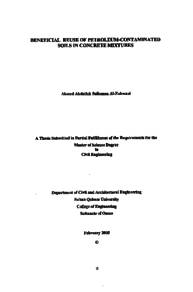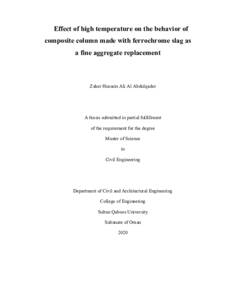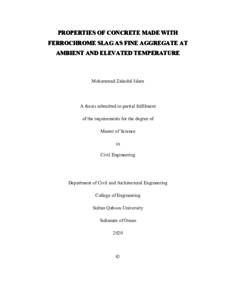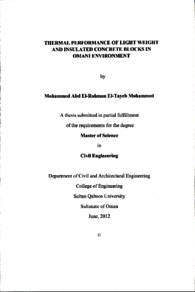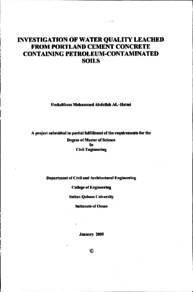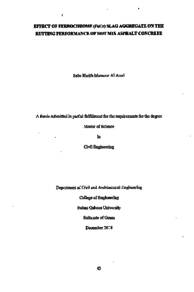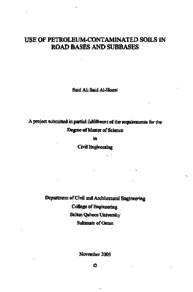Document
Beneficial reuse of petroleum-contaminated soils in concrete mixtures
Publisher
Sultan Qaboos University
Gregorian
2005
Language
English
English abstract
Petroleum-contaminated soils (PCS) result from leaking underground tanks, from oil spills on clean soils, or as a result of soils surrounding petroleum refineries and crude oil wells. Some disposal and treatment techniques generally include: landfilling; bioremediation; and low temperature desorption.
In Oman, Petroleum Development Oman (PDO) generates approximately 53,000 tons/year of PCS. The main objective of this project is to investigate the use of untreated and treated PCS as a sand replacement in concrete. For each PCS type, one group of cement mortar mixes was prepared by replacing the sand fraction using different percentages of PCS (0, 25, 50, 75 and 100%). In addition, two groups of concrete mixes were prepared and five blends were tested by replacing sand with PCS. Groups One and Two included mixtures of PCS/sand ratios of 0, 25, 50, 75 and 100% and 5, 10, 15, 20, 25% (by weight), respectively.
The results obtained for the Group One mixes showed that a concrete mix containing a higher untreated PCS/sand ratio developed lower compressive strength for that mix. The mixes that contained treated PCS generally behaved similarly to the mixes prepared using untreated PCS. The data also showed that untreated PCS mixes yielded a higher compressive strength than treated PCS mixes. The results obtained from the flexural strength test yielded the same trend as that of the compressive strength test. A target 28-day compressive strength of 30 MPa can be achieved using 25% untreated or treated PCS.
The results obtained for Group Two mixes showed that concrete containing higher untreated and treated PCS/sand ratios developed lower compressive strength for all curing periods. Tensile strength test results indicated that treated PCS concrete mixes have higher 7day strength than untreated PC$. The Initial Surface Absorption Test results show that with an increase in PCS content in the concrete mixes, there is an increase in the flow rate with no specific pattern. For the modulus of elasticity test, the values are a function of compressive strength. When the compressive strength increases, there is an increase in the modulus of elasticity.
Recommendations for additional work include: (a) investigate the effect of PCS addition on steel corrosion; (b) examine fatigue and creep properties; and (c) evaluate leachability of toxic heavy metals and organics.
Member of
Resource URL
Arabic abstract
تنتج التربة الملوثة بالبترول عن طريق تسرب الخزانات الموجودة تحت الأرض وأيضا من تناثر البترول على سطح التربة النقية او من التربة المحيطة بالمصافي النفطية وحفر النفط الخام. تتظمن طرق التصريف والمعالجة على التالي: الاندفيلينج، المعالجة البيلوجية، التحليل بالحرارة المنخفضة.
في عمان تتخلص شركة تنمية نفط عمان (PDO) ما يقارب 53٫۰۰۰ ألف طن سنويا من التربة الملوثة بالبترول. الهدف الأساسي من هذا المشروع هو دراسة استخدام التربة الملوثة بالبترول المعالجة والغير معالجة واستبدالها بالرمل المستخدم في الخرسانه لكل نوع من التربة الملوثة تم تحضير مجموعة واحدة من الخلطات الملاط الأسمنتية بإبدال جزء من الرمل واستخدام نسب من التربة الملوثة ( ۰، ۲۰، ۵۰، ۷۰، ۱۰۰%) بالاضافة تم تحضير مجموعتين من الخلطات الخرسانية وتجربة خمسة خلطات بنسب مختلفة بعد إبدال جزء من الرمل بالتربة الملوثة. المجموعة الأولى والثانية حسب التوالي تضمنت خلطات من التربة الملوثة / الرمل المستخدم كالتالي: (.، ۲۰، ۵۰، ۷۰، ۱۰۰% ) وأيضا (۵،۰ ، ۱۰، ۱۰، ۲۰، % ۲۵ ) باستخدام الوزن.
النتائج المستخلصة للخلطات الأسمنتية للمجموعة الأولى توضيح على أن الخلطة الأسمنتية التي تحتوي على نسب اعلى من التربة الغير معالجة من التربة الملوثة انسب الرمل تعطي مقاومة ضعيفة لقوة الضغط لتلك الخلطة الخلطات المعدة باستخدام التربية الغير معالجة تعطي نتائج شبيهة إلى الخلطات المعدة باستخدام التربة المعالجة. النتائج المحصلة للمقاومة الثني تعطي نفس الميل المحصل في فحص مقاومة الضغط.
النتائج المحصلة من المجموعة الثانية من الخلطة الخرسانية توضح ان الخرسانة التي تحتوي على نسبة أعلى من التربية المعالجة والغير معالجة من التربة الملوثة / نسبة الرمل ينتج مقاومة ضغط منخفضة لكل فترات الانضاج في الماء. توضح النتائج المستخلصة من اختبار قوة الشد بان الخلطات التي تحتوي على التربة الملونة المعالجة تعطي مقاومة شد عالية مقارنة بالتربية الغير معالجة للخلطات المنضجة لمدة 7 ايام. أظهرت نتائج فحص الامتصاص بانه بزيادة كمية التربة الملوثة المستخدمة في الخلطة الخرسانية فانه يزيد من معدل الجريان، ولا تعطي النتائج المستخلصة ميل معين لهذه النتائج. لفحص معامل المرونه تضهر النتائج بأن نتائج معامل المرونه مقترنة بنتائج مقاومة الضغط حيث بزيادة مقاومة الضغط يزداد معامل المرونه.
التوصيات لاعمال اضافية في المستقبل تتضمن: ۱- دراسة تأثير التربية الملوثة المضافة في الخلطات الخرسانية على تأكل الحديد. به خصائص الجهد والتزحف يجب ان تفحص هي أيضا. ج. النضوح للمواد السامة والمعادن الثقيلة والمواد العضوية يجب ان تفحص اذا اردنا استخدام هذه التربة في الخلطات الخرسانية.
في عمان تتخلص شركة تنمية نفط عمان (PDO) ما يقارب 53٫۰۰۰ ألف طن سنويا من التربة الملوثة بالبترول. الهدف الأساسي من هذا المشروع هو دراسة استخدام التربة الملوثة بالبترول المعالجة والغير معالجة واستبدالها بالرمل المستخدم في الخرسانه لكل نوع من التربة الملوثة تم تحضير مجموعة واحدة من الخلطات الملاط الأسمنتية بإبدال جزء من الرمل واستخدام نسب من التربة الملوثة ( ۰، ۲۰، ۵۰، ۷۰، ۱۰۰%) بالاضافة تم تحضير مجموعتين من الخلطات الخرسانية وتجربة خمسة خلطات بنسب مختلفة بعد إبدال جزء من الرمل بالتربة الملوثة. المجموعة الأولى والثانية حسب التوالي تضمنت خلطات من التربة الملوثة / الرمل المستخدم كالتالي: (.، ۲۰، ۵۰، ۷۰، ۱۰۰% ) وأيضا (۵،۰ ، ۱۰، ۱۰، ۲۰، % ۲۵ ) باستخدام الوزن.
النتائج المستخلصة للخلطات الأسمنتية للمجموعة الأولى توضيح على أن الخلطة الأسمنتية التي تحتوي على نسب اعلى من التربة الغير معالجة من التربة الملوثة انسب الرمل تعطي مقاومة ضعيفة لقوة الضغط لتلك الخلطة الخلطات المعدة باستخدام التربية الغير معالجة تعطي نتائج شبيهة إلى الخلطات المعدة باستخدام التربة المعالجة. النتائج المحصلة للمقاومة الثني تعطي نفس الميل المحصل في فحص مقاومة الضغط.
النتائج المحصلة من المجموعة الثانية من الخلطة الخرسانية توضح ان الخرسانة التي تحتوي على نسبة أعلى من التربية المعالجة والغير معالجة من التربة الملوثة / نسبة الرمل ينتج مقاومة ضغط منخفضة لكل فترات الانضاج في الماء. توضح النتائج المستخلصة من اختبار قوة الشد بان الخلطات التي تحتوي على التربة الملونة المعالجة تعطي مقاومة شد عالية مقارنة بالتربية الغير معالجة للخلطات المنضجة لمدة 7 ايام. أظهرت نتائج فحص الامتصاص بانه بزيادة كمية التربة الملوثة المستخدمة في الخلطة الخرسانية فانه يزيد من معدل الجريان، ولا تعطي النتائج المستخلصة ميل معين لهذه النتائج. لفحص معامل المرونه تضهر النتائج بأن نتائج معامل المرونه مقترنة بنتائج مقاومة الضغط حيث بزيادة مقاومة الضغط يزداد معامل المرونه.
التوصيات لاعمال اضافية في المستقبل تتضمن: ۱- دراسة تأثير التربية الملوثة المضافة في الخلطات الخرسانية على تأكل الحديد. به خصائص الجهد والتزحف يجب ان تفحص هي أيضا. ج. النضوح للمواد السامة والمعادن الثقيلة والمواد العضوية يجب ان تفحص اذا اردنا استخدام هذه التربة في الخلطات الخرسانية.
Category
Theses and Dissertations

